Indie bands often struggle with collaboration due to technical difficulties and varying digital literacy among members. This article reviews essential digital tools that enhance real-time communication, project management, and file sharing. Key platforms like BandLab and Trello streamline workflows, while regional preferences influence tool selection. Effective practices are also discussed to improve collaboration and creativity within indie bands.
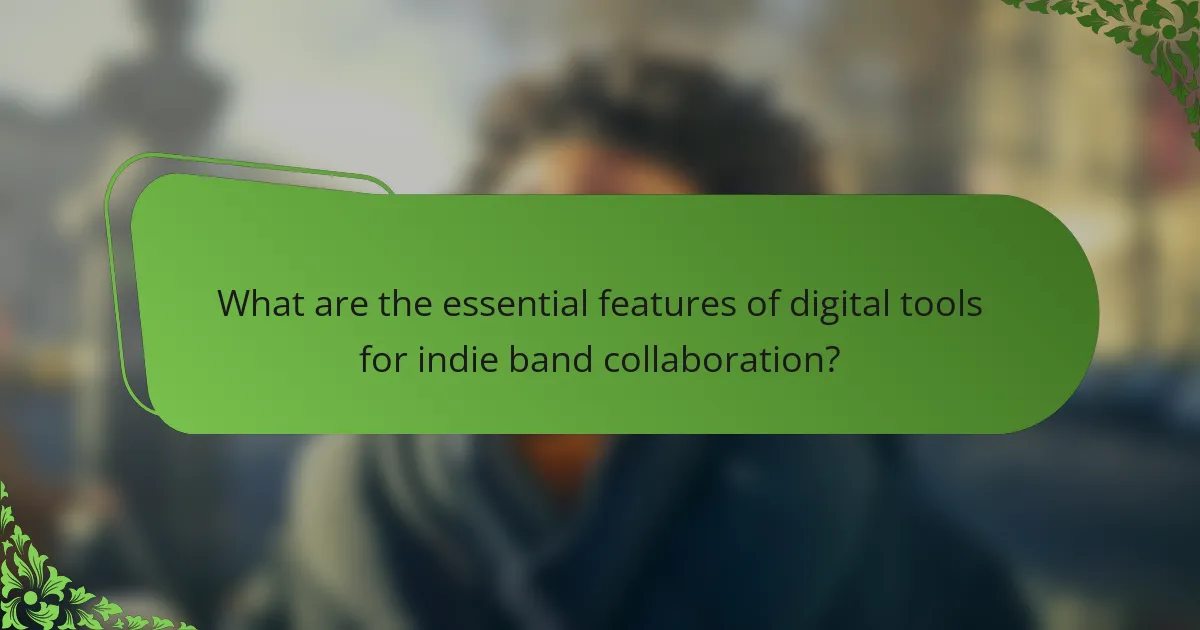
What are the essential features of digital tools for indie band collaboration?
Essential features of digital tools for indie band collaboration include real-time communication, project management capabilities, file sharing, and integration with music production software. These tools enhance workflow efficiency and creativity. Real-time communication facilitates instant feedback, while project management helps track tasks and deadlines. File sharing allows easy access to music files and documents, and integration with production software streamlines the creative process.
How do collaboration tools enhance communication among band members?
Collaboration tools significantly enhance communication among band members by streamlining interactions and improving organization. These tools facilitate real-time messaging, file sharing, and project management, ensuring everyone stays aligned. For instance, platforms like Slack and Trello allow for task assignments and updates, promoting accountability. Enhanced communication leads to quicker decision-making and more effective collaboration, ultimately improving the band’s productivity and creativity.
Which tools offer the best file-sharing capabilities for musicians?
Cloud storage services like Google Drive and Dropbox provide the best file-sharing capabilities for musicians. They enable seamless collaboration and easy access to files from multiple devices. Google Drive offers 15 GB of free storage, while Dropbox provides 2 GB, with options for upgrades. Both platforms allow file sharing through links and support various file formats, making them ideal for sharing music tracks, artwork, and promotional materials. Additionally, services like WeTransfer allow for quick, large file transfers without account requirements, further enhancing collaboration efficiency.
What role do project management features play in band collaboration?
Project management features significantly enhance band collaboration by streamlining communication and organizing tasks. These tools help bands coordinate schedules, share files, and track progress efficiently. Features like task assignment and deadline reminders ensure accountability among members. Additionally, project management tools foster creativity by allowing easy sharing of ideas and feedback, ultimately improving the collaborative process.

Which digital tools are most popular among indie bands in 2025?
In 2025, popular digital tools among indie bands include collaboration platforms, music production software, and social media management tools. These tools enhance communication, streamline workflows, and promote music effectively.
Notable tools are:
1. **BandLab** – A free platform for music creation and collaboration.
2. **Trello** – For project management and task organization.
3. **DistroKid** – Simplifies music distribution to streaming services.
4. **Soundtrap** – An online music studio for real-time collaboration.
5. **Canva** – For designing promotional materials and social media graphics.
These tools collectively improve the efficiency and visibility of indie bands in the competitive music landscape.
What are the user experiences with platforms like BandLab and Splice?
User experiences with platforms like BandLab and Splice vary widely, with many users praising their collaborative features. BandLab offers seamless integration for real-time collaboration, while Splice excels in its extensive sound library and version control. Users appreciate BandLab’s user-friendly interface, which allows easy access to music creation tools. Splice users often highlight the platform’s ability to store and share projects efficiently. Overall, both platforms enhance indie band collaboration through unique features catering to different creative needs.
How do tools like Soundtrap compare to traditional recording methods?
Digital tools like Soundtrap offer greater flexibility and collaboration features compared to traditional recording methods. Soundtrap allows musicians to record remotely, edit in real-time, and access a variety of sound libraries. Traditional methods often require physical studio space and equipment, limiting collaboration.
Soundtrap’s cloud-based platform enables seamless sharing and editing among band members, enhancing productivity. In contrast, traditional recording can be time-consuming and less efficient due to logistical constraints.
Moreover, Soundtrap’s user-friendly interface appeals to indie bands seeking accessible solutions. Traditional methods may demand a steeper learning curve and higher costs for equipment and studio time.
Ultimately, while traditional recording methods provide high-quality sound, digital tools like Soundtrap prioritize convenience and collaboration, making them ideal for indie bands.
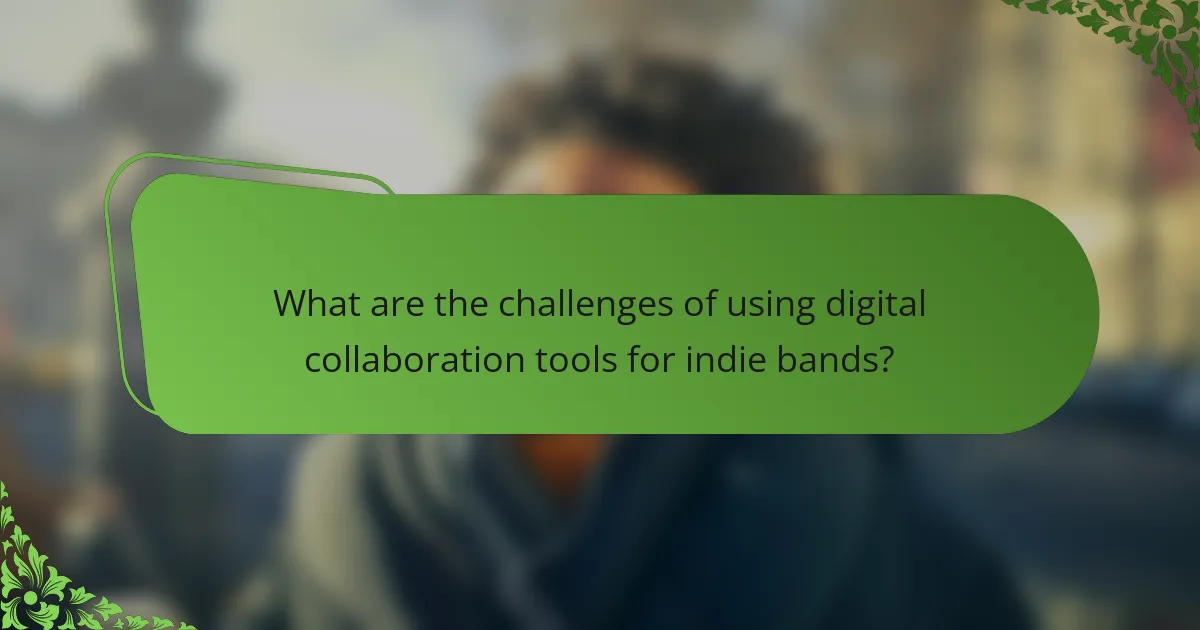
What are the challenges of using digital collaboration tools for indie bands?
Indie bands face several challenges when using digital collaboration tools. Common issues include technical difficulties, varying levels of digital literacy among members, and the potential for miscommunication.
Technical difficulties can arise from software compatibility issues or unreliable internet connections, hindering effective collaboration. Varying levels of digital literacy can lead to frustration among band members, as some may struggle to navigate the tools effectively. Miscommunication can occur due to the lack of face-to-face interaction, making it harder to convey ideas and feedback clearly.
Additionally, the overwhelming number of available tools can create confusion regarding which ones best suit the band’s specific needs. Balancing creativity with the structured nature of digital tools can also pose a challenge, as some members may feel restricted by the software’s limitations.
How can bands overcome technical difficulties when using these platforms?
Bands can overcome technical difficulties by preparing in advance, utilizing reliable software, and maintaining clear communication. Regular testing of equipment and platforms ensures familiarity and reduces unexpected issues. Collaborating with tech-savvy members can enhance problem-solving during live sessions.
What are common user frustrations with digital collaboration tools?
Common user frustrations with digital collaboration tools include poor user interface design, lack of integration with other apps, and insufficient real-time communication features. Users often report difficulties in file sharing and version control, leading to confusion and inefficiencies. Additionally, many tools overwhelm users with unnecessary features, detracting from their primary tasks. Frequent software updates and connectivity issues further exacerbate these frustrations, hindering productive collaboration.
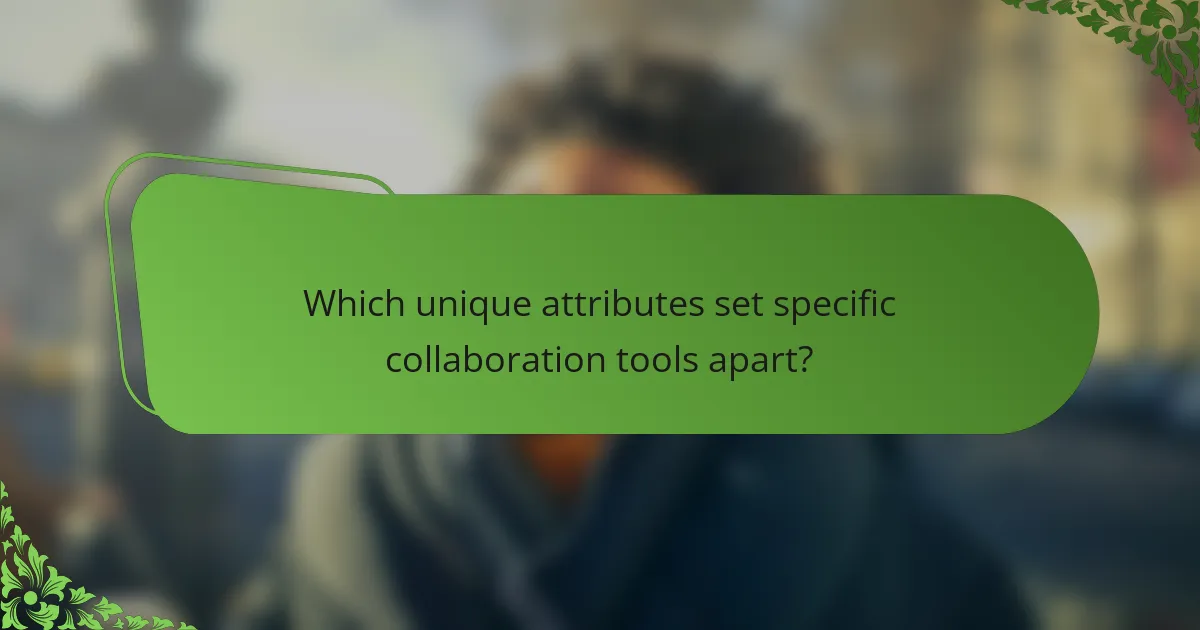
Which unique attributes set specific collaboration tools apart?
Unique attributes that set specific collaboration tools apart include integration capabilities, user interface design, and real-time feedback features. Tools like BandLab excel in seamless music sharing, while Soundtrap offers a highly intuitive interface. Moreover, tools such as Splice provide unique sample libraries that enhance creativity. These distinctions cater to various needs within indie band collaboration.
How does the integration of AI in tools like LANDR enhance collaboration?
The integration of AI in tools like LANDR significantly enhances collaboration by streamlining the music production process. AI-driven features provide real-time feedback, enabling bands to refine their sound collaboratively. Additionally, automated mixing and mastering tools save time and improve audio quality, allowing musicians to focus on creativity. This efficiency fosters a more dynamic and interactive collaboration environment, essential for indie bands aiming to produce high-quality music.
What innovative features do emerging platforms offer to indie musicians?
Emerging platforms offer innovative features like real-time collaboration, cloud storage, and AI-driven music analysis to indie musicians. These tools facilitate seamless communication, enhance creativity, and streamline the production process. For example, platforms like Splice and BandLab provide collaborative workspaces where musicians can share and edit tracks simultaneously. Additionally, AI tools can analyze compositions for trends, helping artists refine their sound. These advancements empower indie musicians to produce high-quality music more efficiently.
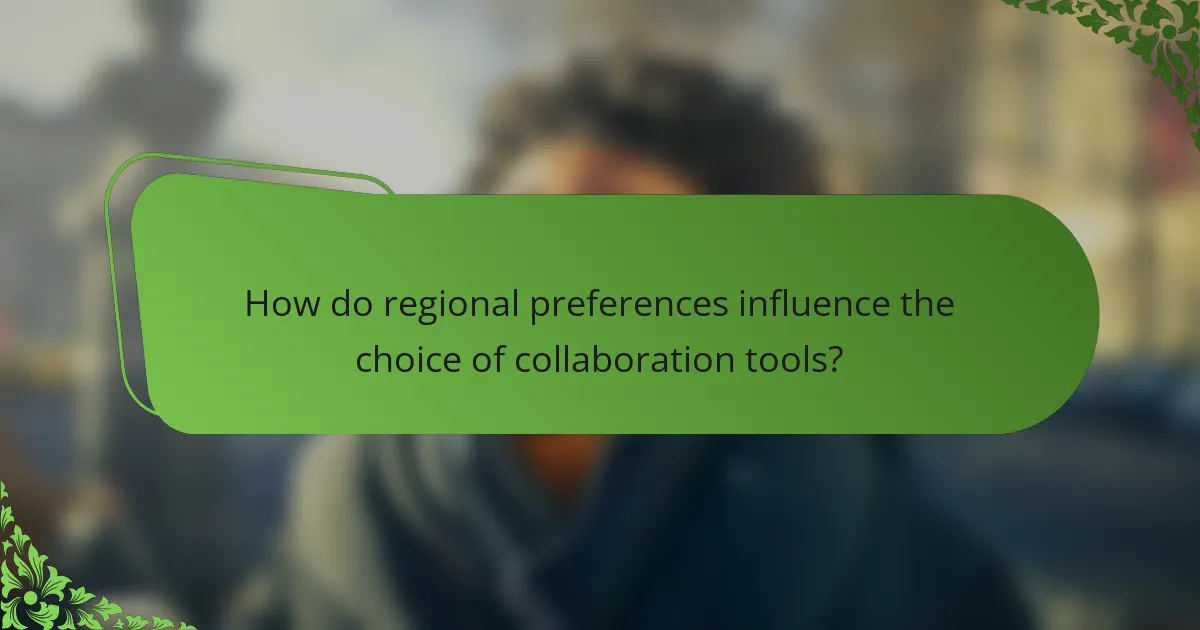
How do regional preferences influence the choice of collaboration tools?
Regional preferences significantly influence the choice of collaboration tools for indie bands. Cultural differences and local music scenes dictate which platforms are favored. For instance, bands in North America may prefer tools like Slack for real-time communication, while European bands might lean towards Trello for project management. Additionally, language support and user interface design play crucial roles in tool adoption. Understanding these regional nuances helps bands select the most effective collaboration tools that align with their working styles and communication needs.
What tools are favored by indie bands in North America compared to Europe?
Indie bands in North America often prefer tools like Bandcamp and SoundCloud, while European bands lean towards platforms such as DistroKid and ReverbNation. Both regions value collaboration tools like Slack and Zoom, but North American bands may favor social media integration more heavily. European bands often utilize local music distribution services, reflecting regional preferences.
How do cultural factors shape the collaboration process for musicians?
Cultural factors significantly influence the collaboration process for musicians by shaping communication styles, creative approaches, and teamwork dynamics. For instance, cultural backgrounds can dictate how feedback is given and received, affecting the overall collaborative atmosphere. Additionally, differing cultural values may impact the prioritization of individual expression versus collective harmony in music creation. These elements can either enhance creativity or create friction, depending on how well the collaborators navigate their cultural differences. Understanding these dynamics is essential for effective use of digital tools in indie band collaboration.
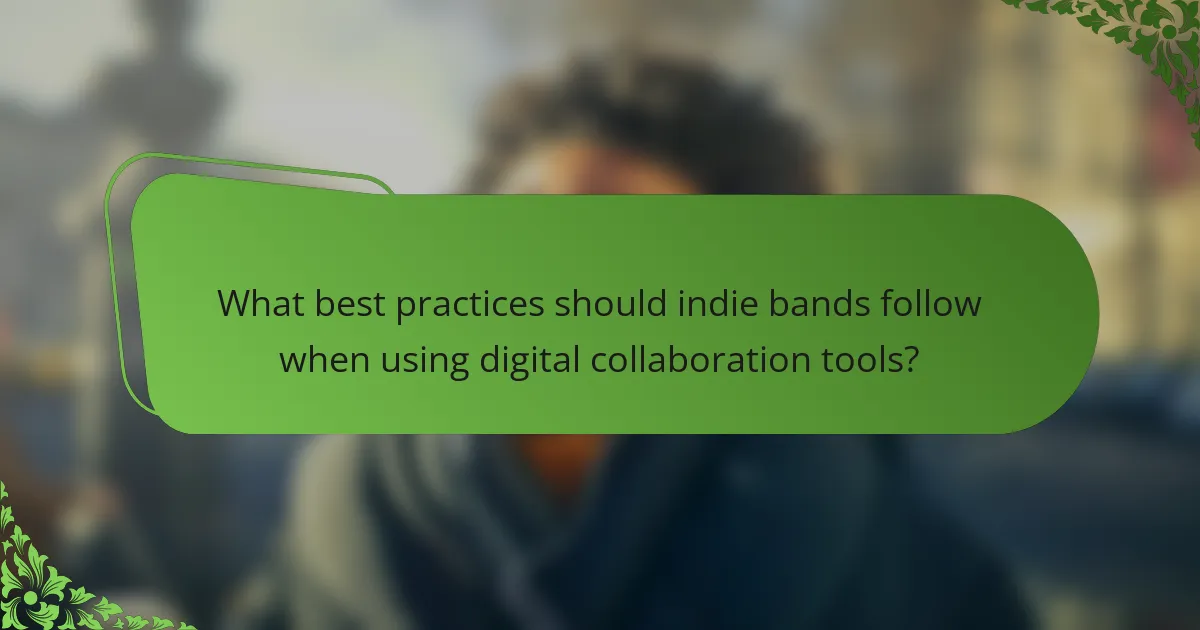
What best practices should indie bands follow when using digital collaboration tools?
Indie bands should prioritize effective communication, select user-friendly tools, and establish clear workflows. These practices enhance collaboration and streamline the creative process.
1. Choose platforms that facilitate real-time communication, such as Slack or Discord.
2. Utilize cloud storage services like Google Drive or Dropbox for easy file sharing.
3. Set up a project management tool, such as Trello or Asana, to organize tasks and deadlines.
4. Schedule regular virtual meetings to maintain engagement and address challenges.
5. Ensure all members are trained on the chosen tools to maximize efficiency.
How can bands effectively manage their workflow using these tools?
Bands can effectively manage their workflow by utilizing digital collaboration tools designed for communication and project management. These tools streamline processes, enhance coordination, and foster creativity among band members. For example, platforms like Trello and Asana help organize tasks, while tools like Slack facilitate real-time communication. Cloud storage solutions, such as Google Drive, allow easy sharing of music files and documents. Integrating these tools can significantly improve productivity and ensure that all members stay aligned on goals and deadlines.
What strategies help maximize the benefits of digital collaboration?
Utilizing effective strategies enhances digital collaboration for indie bands. Prioritize real-time communication tools to ensure seamless interaction. Implement project management software to organize tasks and deadlines efficiently. Encourage regular feedback sessions to foster creativity and resolve conflicts. Leverage cloud storage for easy access to shared files, promoting collaboration on music and marketing materials.
What common mistakes should bands avoid in their collaborative efforts?
Bands should avoid poor communication, unclear roles, and lack of organization in collaborative efforts. Misunderstandings can arise from not using effective digital tools. Establish clear expectations and utilize platforms that facilitate collaboration. Regular check-ins help maintain alignment, ensuring everyone is on the same page.


